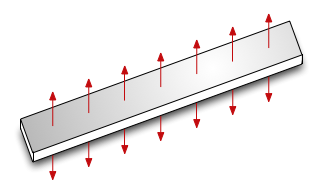Rectangular Free Bar
A model of a wooden rectangular bar unattached at its edges.

'rect-free-bar
(make-object 'rect-free-bar
(modes 80)
(length .3)
(width .05)
(thickness .01)
(density 550)
(young0 1.2e10)
(young1 1.2e10)
(poisson .25)
(freq-loss 8.22e-6)
(const-loss 6.22))
The arguments for the physical parameters can be either numerical values or Modalys controllers (either dynamic or constant). If a given parameter is not supplied when using the Lisp syntax, the default parameter value will be used. Unlike other Modalys objects, this object calculates the optimal number of modes based on the other parameters, so a modes parameter does not need to be provided. This object defaults to 20 points in the x direction and 9 in the z direction.
- modes: number of modes.
- length: length along the y-axis in meters.
- width: width along the x-axis in meters.
- thickness: along the z-axis in meters.
- density: in kg/m^3. See chart of material properties for wood for some appropriate values.
- young0: Young's modulus for the x direction (width), in N/m^2. See chart of wood properties for appropriate values.
- young1: Young's modulus for the z direction (thickness), in N/m^2. See chart of wood properties for appropriate values.
- poisson: poisson ratio. See chart of wood properties for appropriate values.
- freq-loss, const-loss: loss coefficients. See General object information.
Note that, unlike other objects, the values for freq-loss and const-loss default to values corresponding to Padouk (Pterocarpus) wood.
A rectangular bar can be accessed in its z-direction ('normal) from any point on its surface.
(make-access my-bar my-2D-controller 'normal)
This makes an up-and-down access (in the z direction) at a point on the surface of my-plate. The point is defined by my-2D-controller where the first dimension is x and the second is y (the plate's corners being the points (0, 0), (0, 1), (1, 0) and (1, 1)). For example, in order to access the center of the plate we can say:
(make-access my-bar (const 0.5 0.5) 'normal)
Options
A rect-free-bar can be tuned to a specific pitch, using the (set-pitch ...) function, by adjusting one of the following physical parameters:
- 'length
- 'thickness
- 'density
Note that for 'size, both the x and y dimensions are scaled together proportionally in order to preserve the harmonic relationships the plate's mode frequencies.
(setq my-bar (make-object 'rect-free-bar))
(set-pitch my-bar 'length (const 220))
Adjusting the bar width does not greatly affect perceived pitch, but may change the relative harmonicity of the bar.
Modalys Tutorial Example [examples coming soon!]
- Modalys
- Summary
- An Introduction to Modalys
- Objects
- Object Properties
- Object Reference
- One-Mass - Mono-directional (Harmonic Oscillator)
- Two-Mass - Mono-directional
- Two-Mass - Bi-directional
- String (or Rod) - Mono-directional
- String (or Rod) - Bi-directional
- Tube - open/open
- Tube - closed/open
- Tube - closed/closed
- Rectangular Membrane - Fixed
- Circular Membrane - Fixed
- Rectangular Plate - Fixed
- Circular Plate - Clamped
- Circular Plate - Free
- Rectangular Free Bar
- Violin Bridge
- Cello Bridge
- Jet Object
- Single Point Object
- Radiator Object
- Clone Object
- Save Modal Object
- Read Modal Object
- Resonance Model Object
- Piano Soundboard
- Object Utilities
- Hybrid Objects
- String (or Rod) - Mono-directional
- Accesses
- Connections
- Controllers
- The Modalys Workspace
- Appendix
